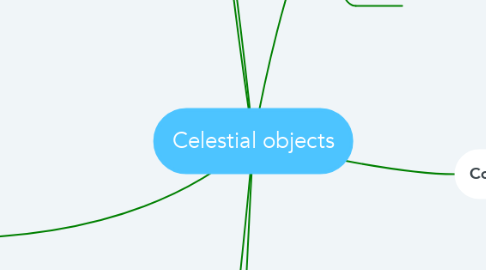Celestial objects
by Asser Omar

1. Sun
1.1. Mass: 1.98892 x 1030 kg. Diameter: 1,391,000 kilometers. Radius: 695,500 km. Surface gravity of the Sun: 27.94 g. Volume of the Sun: 1.412 x 1018 km3 Density of the Sun: 1.622 x 105 kg/m3
1.2. As the Earth rotates around the sun on its annual cycle, it is tilted at an angle on its vertical axis. This impacts how the sun's rays strike various locations on Earth. The Earth is its most extreme tilt at the winter and summer solstices. The sun appears to rise in the east and it sets in the west.
1.3. The sun's gravity pulls the planet toward the sun, which changes the straight line of direction into a curve. This keeps the planet moving in an orbit around the sun. Because of the sun's gravitational pull, all the planets in our solar system orbit around it.
2. Meteors
2.1. a small body of matter from outer space that enters the earth's atmosphere, becoming incandescent as a result of friction and appearing as a streak of light.
2.2. a meteor that survives its passage through the earth's atmosphere such that part of it strikes the ground. More than 90 percent of meteorites are of rock, while the remainder consist wholly or partly of iron and nickel.
2.3. a small body moving in the solar system that would become a meteor if it entered the earth's atmosphere.
2.4. Most meteoroids are made of silicon and oxygen (minerals called silicates) and heavier metals like nickel and iron. Iron and nickel-iron meteoroids are massive and dense, while stony meteoroids are lighter and more fragile.
2.5. All meteorites come from inside our solar system. Most of them are fragments of asteroids that broke apart long ago in the asteroid belt, located between Mars and Jupiter. Such fragments orbit the Sun for some time–often millions of years–before colliding with Earth.
3. Planets
3.1. a celestial body moving in an elliptical orbit around a star.
3.2. The inner planets are closer to the Sun and are smaller and rockier. The outer planets are further away, larger and made up mostly of gas. The inner planets (in order of distance from the sun, closest to furthest) are Mercury, Venus, Earth and Mars
3.3. The four outer planets are all gas giants made primarily of hydrogen and helium. They have thick gaseous outer layers and liquid interiors. The outer planets have numerous moons, as well as planetary rings.
3.4. The International Astronomical Union (IAU) downgraded the status of Pluto to that of a dwarf planet because it did not meet the three criteria the IAU uses to define a full-sized planet. Essentially Pluto meets all the criteria except one—it “has not cleared its neighboring region of other objects.”
4. Moons
4.1. Earth:1, Mars:2, Jupiter: 53, 79, Saturn :53, 62, Uranus: 27,Neptune:14
4.2. The Moon is held in orbit around the Earth by the force of gravity. In turn the Earth and all the other planets in the solar system are held in orbit around the Sun by the force of gravity. ... The combined gravitational pull of the Moon and the Sun on the Earth's oceans cause the ocean tides.
5. Gravity
5.1. Gravity, also called gravitation, in mechanics, the universal force of attraction acting between all matter. ... On Earth all bodies have a weight, or downward force of gravity, proportional to their mass, which Earth's mass exerts on them. Gravity is measured by the acceleration that it gives to freely falling objects.
5.2. Anything that has mass also has gravity. Objects with more mass have more gravity. Gravity also gets weaker with distance. So, the closer objects are to each other, the stronger their gravitational pull is.
5.3. Gravity gets weaker with distance. So, the closer objects are to each other, the stronger their gravitational pull is.
5.4. gravity
6. Asteroids
6.1. a small rocky body orbiting the sun. Large numbers of these, ranging in size from nearly 600 miles (1,000 km) across (Ceres) to dust particles, are found (as the asteroid belt ) especially between the orbits of Mars and Jupiter, though some have more eccentric orbits, and a few pass close to the earth or enter the atmosphere as meteors.
6.2. Asteroids are found in the asteroid belt especially between the orbits of Mars and Jupiter, though some have more eccentric orbits, and a few pass close to the earth or enter the atmosphere as meteors.
6.3. Nearly all asteroids are irregularly shaped, although a few of the largest are nearly spherical, such as Ceres. They are often pitted or cratered — for instance, Vesta has a giant crater some 285 miles (460 km) in diameter. The surfaces of most asteroids are thought to be covered in dust.
7. Comets
7.1. Comets are cosmic snowballs of frozen gases, rock and dust that orbit the Sun. ... When frozen, they are the size of a small town. When a comet's orbit brings it close to the Sun, it heats up and spews dust and gases into a giant glowing head larger than most planets.
7.2. Oort Cloud Comets orbit the sun, but most are believed to inhabit in an area known as the Oort Cloud, far beyond the orbit of Pluto. Occasionally a comet streaks through the inner solar system; some do so regularly, some only once every few centuries.
7.3. Comets are icy bodies in space that release gas or dust. They are often compared to dirty snowballs, though recent research has led some scientists to call them snowy dirtballs. Comets contain dust, ice, carbon dioxide, ammonia, methane and more.


